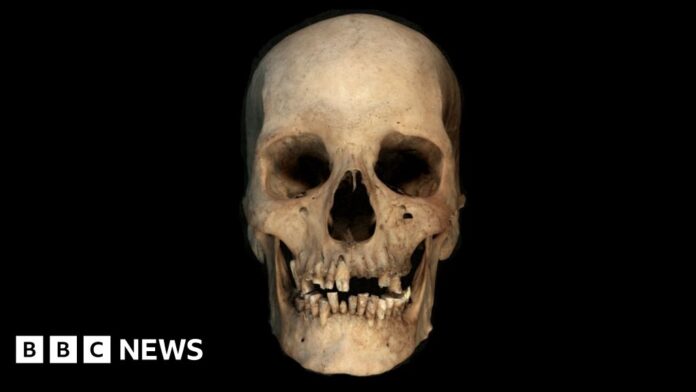
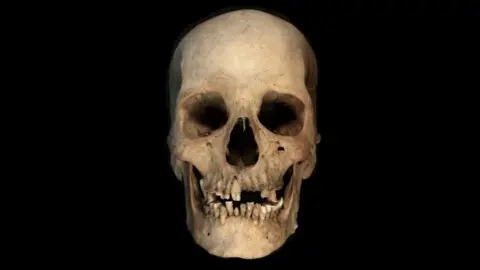 Liverpool John Moores University. Nature
Liverpool John Moores University. NatureA DNA bone test on a man who lived 4,500 years ago in the Nile Valley has shed new light on the rise of the Ancient Egyptian civilisation.
An analysis of his skeleton shows he was 60 years old and possibly worked as a potter, but also that a fifth of his DNA came from ancestors living 1,500km away in the other great civilisation of the time, in Mesopotamia or modern day Iraq.
It is the first biological evidence of links between the two and could help explain how Egypt was transformed from a disparate collection of farming communities to one of the mightiest civilisations on Earth.
The findings lend new weight to the view that writing and agriculture arose through the exchange of people and ideas between these two ancient worlds.
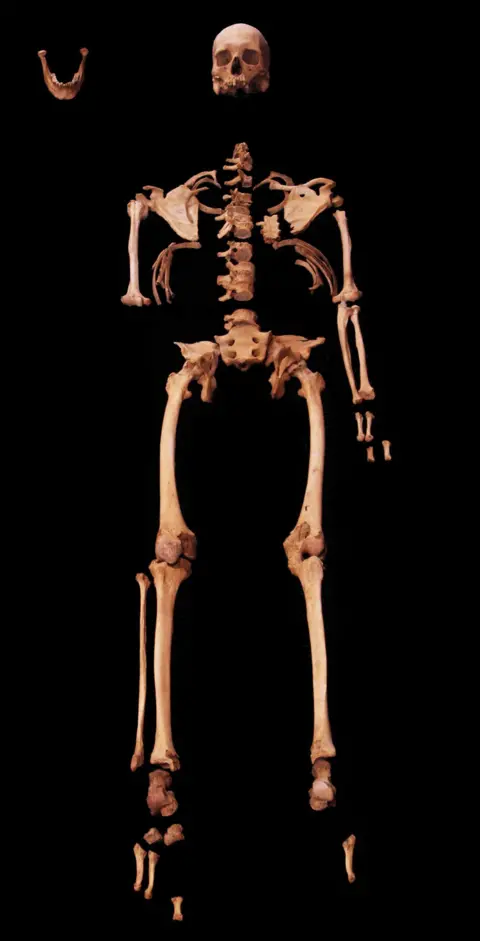 Liverpool John Moores University/Nature
Liverpool John Moores University/NatureThe lead researcher, Prof Pontus Skoglund at the Francis Crick Institute in London, told BBC News that being able to extract and read DNA from ancient bones could shed new light on events and individuals from the past, allowing black and white historical facts to burst into life with technicolour details.
“If we get more DNA information and put it side by side with what we know from archaeological, cultural, and written information we have from the time, it will be very exciting,” he said.
Our understanding of our past is drawn in part from written records, which is often an account by the rich and powerful, mostly about the rich and powerful.
Biological methods are giving historians and scientists a new tool to view history through the eyes of ordinary people.
The DNA was taken from a bone in the inner ear of remains of a man buried in Nuwayrat, a village 265km south of Cairo.
He died between 4,500 and 4,800 years ago, a transformational moment in the emergence of Egypt and Mesopotamia. Archaeological evidence indicated that the two regions may have been in contact at least 10,000 years ago when people in Mesopotamia began to farm and domesticate animals, leading to the emergence of an agricultural society.
Many scholars believe this social and technological revolution may have influenced similar developments in ancient Egypt – but there has been no direct evidence of contact, until now.
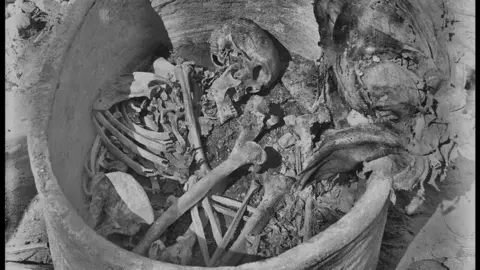 Garstang Museum/Liverpool University/Nature
Garstang Museum/Liverpool University/NatureAdeline Morez Jacobs, who analysed the remains as part of her PhD at Liverpool John Moores University, says this is the first clear-cut evidence of significant migration of people and therefore information between the two centres of civilisation at the time.
“You have two regions developing the first writing systems, so archaeologists believe that they were in contact and exchanging ideas. Now we have the evidence that they were.
“We hope that future DNA samples from ancient Egypt can expand on when precisely this movement from West Asia started and its extent.”
The man was buried in a ceramic pot in a tomb cut into the hillside. His burial took place before artificial mummification was standard practice, which may have helped to preserve his DNA.
By investigating chemicals in his teeth, the research team were able to discern what he ate, and from that, determined that he had probably grown up in Egypt.
But the scientific detective story doesn’t stop there.
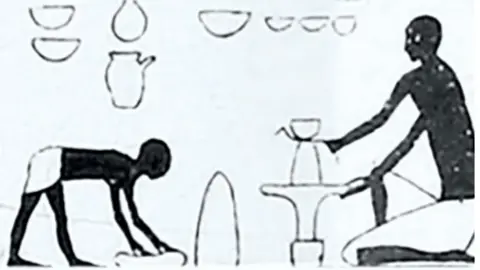 The Metropolitan Museum of Art
The Metropolitan Museum of ArtProf Joel Irish at Liverpool John Moores University conducted a detailed analysis of the skeleton to build up a picture of the man as an individual.
“What I wanted to do was to find out who this guy was, let’s learn as much about him as possible, what his age was, his stature was, what he did for a living and to try and personalise the whole thing rather than treat him as a cold specimen,” he said.
The bone structure indicated that the man was between 45 and 65 years old, though evidence of arthritis pointed to the upper end of the scale. He was just over 5ft 2in tall, which even then was short.
Prof Irish was also able to establish he was probably a potter. The hook-shaped bone at the back of his skull was enlarged, indicating he looked down a lot. His seat bones are expanded in size, suggesting that he sat on hard surfaces for prolonged periods. His arms showed evidence of extensive movement back and forth, and there were markings on his arms where his muscles had grown, indicating that he was used to lifting heavy objects.
“This shows he worked is tail off. He’s worked his entire life,” the American-born academic told BBC News.
Dr Linus Girdland Flink explained that it was only because of a tremendous stroke of luck that this skeleton was available to study and reveal its historic secrets.
“It was excavated in 1902 and donated to World Museum Liverpool, where it then survived bombings during the Blitz that destroyed most of the human remains in their collection. We’ve now been able to tell part of the individual’s story, finding that some of his ancestry came from the Fertile Crescent, highlighting mixture between groups at this time,” he said.
The new research has been published in the journal Nature.
A DNA bone test on a man who lived 4,500 years ago in the Nile Valley has shed new light on the rise of the Ancient Egyptian civilisation.
An analysis of his skeleton shows that a fifth of his DNA came from ancestors living 1,500km away in the other great civilisation of the time, in Mesopotamia or modern day Iraq.
It is the first biological evidence of links between the two civilisations, and could help explain how Egypt was transformed from a disparate collection of farming communities to one of the mightiest civilisations on Earth.
The findings lend new weight to the view that writing and agriculture arose through the exchange of people and ideas between these two ancient worlds.


